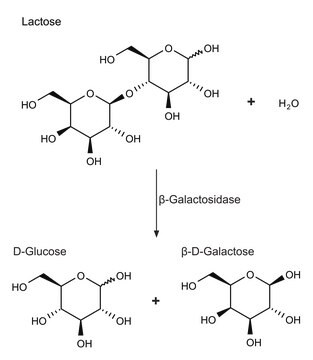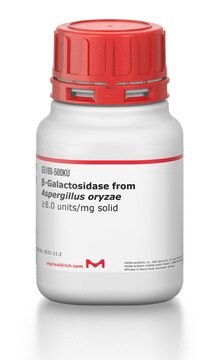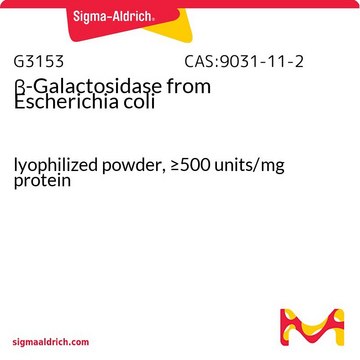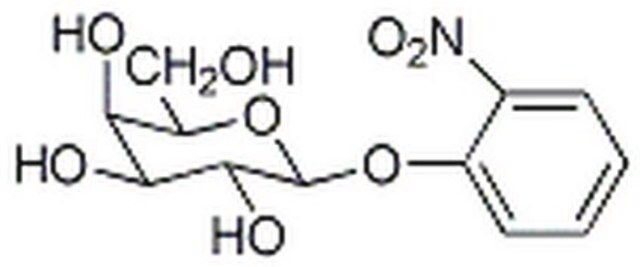G6008
β-Galactosidase from Escherichia coli
Grade VI, lyophilized powder, ≥250 units/mg protein
Sinonimo/i:
β-D-Galactoside galactohydrolase, Lactase
Autenticatiper visualizzare i prezzi riservati alla tua organizzazione & contrattuali
About This Item
Prodotti consigliati
Origine biologica
Escherichia coli
Livello qualitativo
Tipo
Grade VI
Stato
lyophilized powder
Attività specifica
≥250 units/mg protein
PM
465 kDa
non contiene
BSA as extender
Composizione
Protein, ≥50% biuret
Condizioni di spedizione
wet ice
Temperatura di conservazione
−20°C
Cerchi prodotti simili? Visita Guida al confronto tra prodotti
Descrizione generale
β-Galactosidase is a tetramer consisting of four equal subunits of 135,000 Da each. It is a sulfhydryl containing enzyme, with 19 cysteine residues per subunit.
Applicazioni
β-Galactosidase is conjugated to an antibody that specifically recognizes a target molecule (enzyme immunoassay or EIA). β-Galactosidase is also used as a reporter enzyme to monitor the level of gene expression of a promoter.
Azioni biochim/fisiol
β-galactosidase cleaves lactose into its monosaccharide components, glucose and galactose. It also catalyses the transglycosylation of glucose into allolactose, the inducer of β-galactosidase, in a feedback loop.
β-galactosidase cleaves lactose into its monosaccharide components, glucose and galactose. It also catalyses the transglycosylation of glucose into allolactose, the inducer of β-galactosidase, in a feedback loop.
Proprietà fisiche
Tetramer molecular weight 465 kDa (subunits 116.3 kDa each)
Definizione di unità
One unit will hydrolyze 1.0 μmole of o-nitrophenyl β-D-galactoside to o-nitrophenol and D-galactose per min at pH 7.3 at 37 °C.
Stato fisico
Partially purified; contains Tris buffer salts, magnesium chloride, DL-dithiothreitol and 2-mercaptoethanol
Inibitore
Substrato
N° Catalogo
Descrizione
Determinazione del prezzo
Codice della classe di stoccaggio
11 - Combustible Solids
Classe di pericolosità dell'acqua (WGK)
WGK 3
Punto d’infiammabilità (°F)
Not applicable
Punto d’infiammabilità (°C)
Not applicable
Dispositivi di protezione individuale
Eyeshields, Gloves, type N95 (US)
Scegli una delle versioni più recenti:
Possiedi già questo prodotto?
I documenti relativi ai prodotti acquistati recentemente sono disponibili nell’Archivio dei documenti.
I clienti hanno visto anche
David P Klebl et al.
Frontiers in molecular biosciences, 9, 945772-945772 (2022-08-23)
Advances in single particle cryo-EM data collection and processing have seen a significant rise in its use. However, the influences of the environment generated through grid preparation, by for example interactions of proteins with the air-water interface are poorly understood
PURIFICATION, COMPOSITION, AND MOLECULAR WEIGHT OF THE BETA-GALACTOSIDASE OF ESCHERICHIA COLI K12.
G R CRAVEN et al.
The Journal of biological chemistry, 240, 2468-2477 (1965-06-01)
D C Young et al.
Analytical biochemistry, 215(1), 24-30 (1993-11-15)
Bacterial beta-galactosidase is one of several reporter enzymes used in studying the transcriptional activity of eukaryotic promoters. Although it is one of the easiest and least expensive enzymes to assay, its use has been limited because of its low sensitivity
K Kato et al.
Journal of immunology (Baltimore, Md. : 1950), 116(6), 1554-1560 (1976-06-01)
1. A method for the conjugation of the Fab' fragment of rabbit IgG with beta-D-galactosidase from Escherichia coli is described. The method consists of two main steps: treatment of the Fab' fragments containing sulfhydryl groups with excess N,N'-o-phenylenedimaleimide, to introduce
D H Juers et al.
Protein science : a publication of the Protein Society, 8(1), 122-136 (1999-04-21)
Beta-galactosidase (lacZ) from Escherichia coli is a 464 kDa homotetramer. Each subunit consists of five domains, the third being an alpha/beta barrel that contains most of the active site residues. A comparison is made between each of the domains and
Il team dei nostri ricercatori vanta grande esperienza in tutte le aree della ricerca quali Life Science, scienza dei materiali, sintesi chimica, cromatografia, discipline analitiche, ecc..
Contatta l'Assistenza Tecnica.












